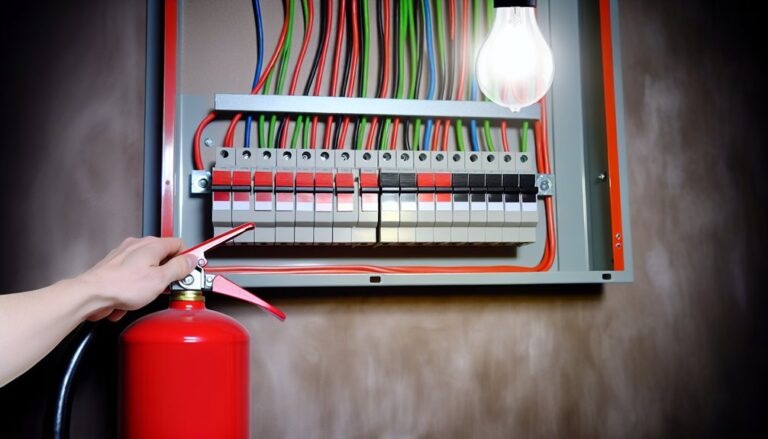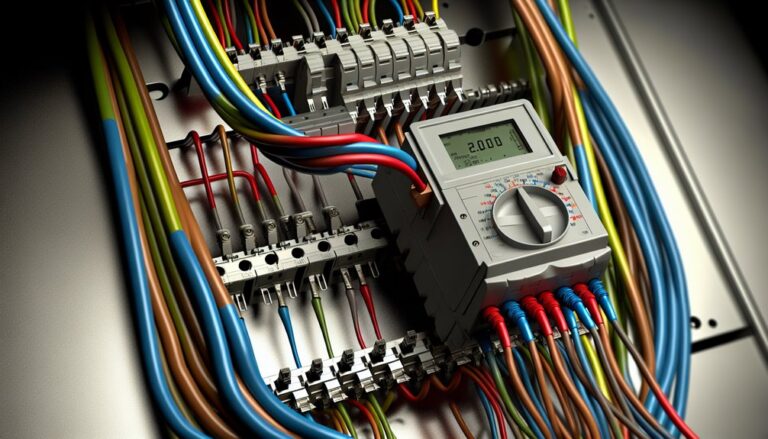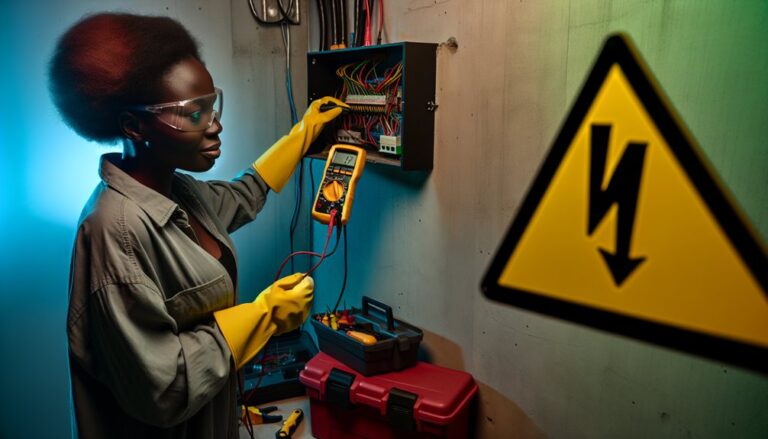Improving Electrical Reliability
To improve electrical reliability, focus on regular maintenance, smart technology integration, and effective backup power solutions. Schedule routine inspections to catch potential issues early and guarantee system performance. Use smart sensors to monitor critical parameters in real-time, identifying anomalies before they escalate. Invest in uninterruptible power supplies and generators for seamless power continuity during outages. Upgrading grid infrastructure and adopting energy management systems further enhance reliability. Discover how implementing these strategies can optimize your electrical systems.
Key Takeaways
- Implement regular maintenance schedules to identify and resolve issues before they lead to system failures.
- Utilize smart technology for real-time monitoring and predictive analytics to detect anomalies early.
- Invest in robust backup power solutions, such as UPS and generators, to ensure operational continuity during outages.
- Enhance grid infrastructure by upgrading transmission lines and deploying smart grid technologies for improved efficiency.
- Foster fault tolerance through redundant systems and failover mechanisms to maintain performance during component failures.
Understanding Electrical Reliability
Electrical reliability refers to the ability of an electrical system to consistently perform its intended function without failure.
To achieve this, you need to focus on fault tolerance and system resilience. Fault tolerance allows your system to continue operating despite component failures, ensuring minimal downtime. By incorporating redundant systems and failover mechanisms, you enhance this capability.
System resilience, on the other hand, is about your system’s ability to recover from disruptions. This involves designing for flexibility and adaptability, enabling your infrastructure to withstand and quickly respond to unexpected events.
Understanding these concepts is essential; they form the foundation for building and maintaining reliable electrical systems capable of meeting operational demands effectively.
Prioritizing these factors will greatly improve your system’s overall reliability.
The Importance of Regular Maintenance
While many may overlook routine upkeep, regular maintenance is essential for guaranteeing the long-term reliability of electrical systems. Neglecting this aspect can lead to costly failures and unsafe conditions.
By adhering to maintenance schedules, you can markedly enhance system performance. Key components of an effective maintenance plan include:
- Preventive Inspections: Regularly evaluate critical systems to identify potential issues before they escalate.
- System Cleaning: Dust and debris can hinder performance, so make certain components are clean and free from obstructions.
- Calibration and Testing: Regularly check equipment settings and functionality to maintain peak operation.
Implementing these strategies not only minimizes downtime but also extends the lifespan of your electrical systems.
Prioritizing regular maintenance is a proactive approach to reliability.
Utilizing Smart Technology for Monitoring
Regular maintenance sets the foundation for effective monitoring, and integrating smart technology can additionally enhance your electrical system’s reliability.
By employing smart sensors, you can continuously track critical parameters like voltage, current, and temperature. These sensors provide real-time data, enabling you to identify anomalies before they escalate into significant issues.
Coupled with predictive analytics, you can analyze historical data to forecast potential failures, allowing you to take proactive measures. This combination not only minimizes downtime but also optimizes maintenance schedules, ensuring resources are allocated efficiently.
Additionally, smart technology facilitates remote monitoring, giving you instant access to your system’s performance. Embracing these advancements positions you to achieve greater reliability and efficiency in your electrical operations.
Investing in Backup Power Solutions
Investing in backup power solutions is essential for maintaining operational continuity during outages. By ensuring you have reliable systems in place, you can mitigate risks that could disrupt your business.
Consider these three options:
- Portable Generators: These are ideal for short-term power needs and can be quickly deployed in emergencies.
- UPS Systems: Uninterruptible Power Supplies provide instant power during outages, keeping critical systems running and preventing data loss.
- Hybrid Solutions: Combining both generators and UPS systems can offer extensive coverage, adapting to various power demands.
Integrating Renewable Energy Sources
Integrating renewable energy sources into your electrical system not only enhances reliability but also aligns with sustainability goals.
By implementing solar integration, you can harness the sun’s energy, which provides a consistent power supply, especially during peak demand hours. This reduces strain on conventional power plants and limits outages.
Additionally, incorporating wind energy into your energy mix adds another layer of reliability, as wind turbines can generate electricity even when solar is unavailable.
To optimize performance, you should employ smart grid technology that dynamically balances these renewable sources, ensuring a seamless shift between energy types.
Enhancing Grid Infrastructure
As you incorporate renewable energy sources, enhancing grid infrastructure becomes essential to support the increased complexity and demand on the system.
To achieve this, consider implementing effective grid resiliency strategies and committing to infrastructure investment. Here are three key actions:
- Upgrade Transmission Lines: Modernizing outdated transmission lines enhances capacity and reduces losses.
- Deploy Smart Grid Technologies: Integrating advanced monitoring and control systems improves operational efficiency and responsiveness to fluctuations.
- Create Energy Storage Solutions: Investing in battery and other storage technologies helps balance supply and demand, providing stability during peak loads.
Implementing Energy Management Systems
To effectively manage the complexities of modern energy systems, implementing energy management systems (EMS) is essential. An EMS allows you to optimize energy efficiency by analyzing consumption patterns and identifying areas for improvement.
By leveraging real-time data, you can make informed decisions that enhance operational performance while reducing costs.
Furthermore, incorporating demand response strategies within your EMS enables you to adjust energy usage during peak periods, alleviating strain on the grid. This proactive approach not only promotes sustainability but also enhances overall reliability by balancing supply and demand effectively.
Ultimately, adopting an EMS equips your organization with the tools necessary to navigate the evolving energy landscape, ensuring that you maintain operational integrity while maximizing efficiency and responsiveness.
Educating Consumers on Electrical Safety
While many consumers rely on electrical appliances for daily tasks, understanding electrical safety is essential to prevent accidents and guarantee a secure environment.
You can greatly reduce the risk of electrical hazards by adhering to key safety practices:
- Regular Inspections: Check cords and plugs for damage. Replace any frayed or worn wires immediately.
- Use Ground Fault Circuit Interrupters (GFCIs): Install GFCIs in areas prone to moisture, such as bathrooms and kitchens, to protect against electrical shocks.
- Educate Yourself and Family: Teach everyone in your household about the risks of overloading outlets and the importance of unplugging unused devices.
Collaborating With Utility Providers
Collaborating with utility providers can considerably enhance electrical reliability within communities.
Establishing utility partnerships is vital for optimizing infrastructure and ensuring seamless service delivery. By negotiating robust service agreements, you can gain access to essential resources and support for maintenance and upgrades. These agreements often outline clear responsibilities and expectations, fostering accountability on both sides.
Regular communication with utility providers helps identify potential issues before they escalate, enabling proactive measures to be implemented swiftly. Furthermore, joint initiatives for infrastructure improvement can lead to enhanced system resilience against outages.
In this way, you not only strengthen the reliability of electrical services but also create a collaborative environment focused on continuous improvement in energy delivery.
About Us
We understand that electrical issues can be stressful and overwhelming. That’s why we are here to lend a helping hand and provide you with the best electrical services in town. As a team of experienced electricians, we take pride in our ability to solve any electrical problem with precision and care.
Pages
Follow us
© 2025 By Electrician Fort Lauderdale Today








